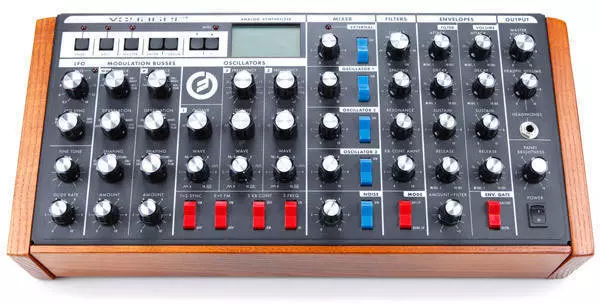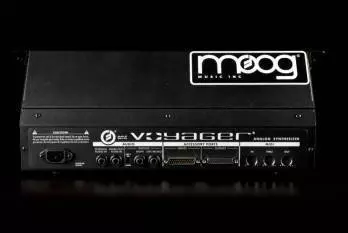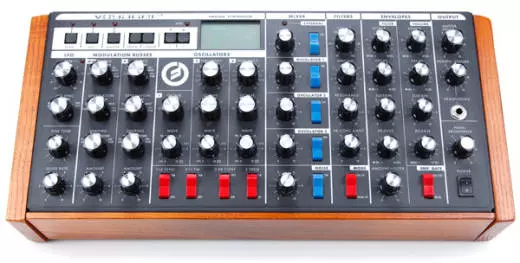Moog Minimoog Voyager Synthesizer - Rackmount Edition

Additional Photos:

The Voyager Rack Mount Edition contains all the synthesis functions of the award-winning Voyager. It also includes the Electric Blue back lit panel that we introduced with the Anniversary Edition Voyager, complete with front panel brightness control. A new feature is the switchable output mode. A slider switch on the rear panel selects -2dBm unbalanced, floating outputs, or +4 dBm, 600 Ohm electronically balanced outputs for professional applications. Also new is the Input Accessory Port, for CV/Gate Inputs.
The Voyager Rack Mount Edition can be controlled completely through MIDI. All front panel controls transmit and receive MIDI Continuous Controller messages. Match the RME (or up to 16 of them!) up with your existing Voyager to achieve some serious polyphony.
Now, all Rack Mount Editions will have the upgraded software and hardware to allow the player 7 banks of 128 presets and the following capabilities:
The External Mixer knob (just right of the display panel) has a dual function that allows you to rapidly change presets as opposed to continuously punching the cursor buttons.
MIDI Enhancements:
- Allows you to send either 7 or 14 bit resolution from the Mod Wheel.
- Optionally reduces the amount of MIDI data being sent from the Touch Surface.
(These changes enable the Voyager to work better with older MIDI equipment.)
Specs:
The Minimoog Voyager Rack Mount Edition Synthesizer is a monophonic (one note at a time) analog performance synthesizer housed in a 5U Rack Mount Enclosure. The signal path starts with a bank of three wide-range, high-stability voltage controlled oscillators, one noise source, and one audio preamplifier for externally-applied audio signals. The sound modifiers are a dual mode filter module, containing a dual Moog lowpass mode and a highpass/lowpass mode and one stereo VCA (Voltage Controlled Amplifier). Modulation sources are two ADSR (Attack Decay Sustain Release) envelope generators and one multiwaveform LFO (Low Frequency Oscillator).
The digital functions of the Voyager allow for storage of presets, transmitting and reception of MIDI, and software upgrades via MIDI. The User Interface is a LCD display with variable contrast, +1/-1 and cursor buttons for navigation, an Enter button for executing functions, and 3 Mode functions for determining the operation mode of the Voyager. Master Mode allows access to Global Settings and Utilities; Edit Mode allows access to Items stored as a Preset, and performs the Save function; Panel Mode allows access to the presets and is the mode used for performance, as well as performance related features.
Oscillators Module Three wide-range, high stability VCOs (Voltage Controlled Oscillators) with continuously variable waveforms.
• Two FREQUENCY controls vary the frequencies of Oscillators #2 and #3 over a +/-7 semitone range with respect to Oscillator #1.
• Three OCTAVE selectors set the frequency ranges of the oscillators in six octave steps.
• Three WAVE controls provide continuous control over the waveforms of the oscillators, from triangular, to sawtooth, to square, to narrow rectangular.
• 1-2 SYNC switch synchronizes the Oscillator #2 waveform to the frequency of Oscillator #1, for dramatic timbral effects.
• 3-1 FM switch provides linear frequency modulation of Oscillator #1 by Oscillator #3.
• 3 KEYBOARD CONTROL switch disconnects Oscillator #3 from control by the keyboard CV, enabling it to function as a drone or a modulation source independent of the keyboard.
• 3 FREQ switch lowers the frequency of Oscillator #3 into the sub-audio range, enabling it to function as a low frequency audio or modulating oscillator.
Mixer Module Five-input mixer for combining the audio sources prior to filtering. • Five Input Level controls adjust the relative levels of the oscillator, noise, and external audio input signals.
• Five Input switches enable the player to quickly switch individual audio signals in and out.
• External Level LED enables the player to set the correct external audio signal level.
Filters Module Dual mode filter module includes two Moog lowpass-resonant filters in parallel to stereo output or a highpass and lowpass-resonant filters in series, for highpass, bandpass, or lowpass filtering.
• CUTOFF control sweeps the frequencies of both filters throughout the audio range.
• SPACING control sets the spacing between the frequencies of the two lowpass filters or controls the frequency of the highpass filter, over a +/-3 octave range.
• RESONANCE control adjusts the resonance of both filters, from none to filter oscillation.
• KEYBOARD CONTROL AMOUNT control sets how much the filters open and close as the player presses different keys on the keyboard controlling the Voyager Rack Mount.
• DUAL LOWPASS/ HIGHPASS-LOWPASS switch selects between two lowpass filters in parallel or a lowpass and highpass filter in series.
Envelopes Module The Envelopes Module generates two wide-range ADSR (Attack Decay Sustain Release) envelopes. The Filter Envelope sweeps the filter and is available for modulation shaping. The Volume Envelope shapes the overall volume.
• Two ATTACK controls determine the attack times of the envelopes.
• Two DECAY controls determine the decay time constants of the envelopes.
• Two SUSTAIN controls determine the sustain levels of the envelopes.
• Two RELEASE controls determine the release time constants of the envelopes.
• AMOUNT TO FILTER control determines how much the filter envelope will open and close the filter, from full negative (inverted envelope) to full positive (non-inverted envelope).
• ENVELOPE GATE switch selects whether the envelopes will be triggered by the keyboard or by programmable envelope gate sources, including Keyboard Gate, S+H Gate (LFO), and MIDI Clock, allowing independent triggering of the two envelopes.
LFO Module Low Frequency Oscillator generates triangular, square, Sample & Hold, and smoothed Sample & Hold waveforms for use as modulating signals.
• RATE control sets the LFO rate over the range 0.2 Hz (one cycle every five seconds) to 50 Hz (50 times a second).
• SYNC selector selects LFO synchronization source to be from the keyboard gate, MIDI Clock, external gate, or off (no synchronization).
• RATE LED provides visual indication of the LFO rate.
Modulation Busses Module Selects the sources, destinations, and shaping signals for the MOD WHEEL bus and the PEDAL/ON bus.
• Two SOURCE selectors select the modulation source from the LFO waveforms, Oscillator# 3, the MOD2 Voltage, or a software selectable source whose default is noise.
• Two DESTINATION selectors select the modulation destination from the pitch of all the audio oscillators, just Oscillator #2, just Oscillator #3, the filter frequencies, the oscillator waveforms, or a software selectable destination whose default is LFO Rate.
• Two SHAPING selectors select the filter envelope, key pressure signal, key velocity or a software selectable source whose default is on to shape the modulation signal on that bus.
• Two AMOUNT controls set the overall modulation amount for each bus.
Output Module • MASTER VOLUME control sets the overall level of the instruments audio outputs.
• HEADPHONE VOLUME control sets the overall level of the headphone output.
• HEADPHONES JACK: 1/4" tip-ring-sleeve phone jack for regular stereo headphones.
Glide and Fine Tune Module • GLIDE varies the speed at which the keyboard voltage changes, from instantaneous to several seconds.
• FINE TUNE adjusts the overall tuning of the instrument.
Digital/ MIDI Implementation Capabilities for OS Version 2.6 • FRONT PANEL STORAGE AND RECALL: Except for the Fine Tuning control, the settings of all front panel controls, selectors, and switches are stored in the nonvolatile digital memory. A total of one hundred twenty eight front panel programs may be stored for instant recall. Presets are saved in EDIT mode.
• CONTROL OF FRONT PANEL PARAMETERS THROUGH MIDI: All front panel parameters except for fine tune and headphone volume are controllable through MIDI Control Change commands.
• TRANSMISSION OF FRONT PANEL SETTING VIA MIDI: Setting of all panel controls, selectors, and switches except for fine tune and headphone volume transmit MIDI Control Change Commands. Potentiometer controls transmit 14 bit CCs
• UPLOADING AND DOWNLOADING OF BANKS OF SETTINGS VIA MIDI: Entire banks or individual presets may be uploaded and downloaded via MIDI.
• UPDATING OF OPERATING SOFTWARE VIA MIDI: The instruments operating software can be updated via standard MIDI (.MID) or Sysex (.SYX) files which will be available on Moog Musics web site: www.moogmusic.com.
• PANEL MODE FEATURES:
-Quick Mode
-Parameter Display
-Master/HP Volume
-LCD Contrast
-T.S. Reduction
-Ext. Audio Pot
-Glide Function
-Release Function
• EDIT MODE FEATURES:
-Compare to Preset
-Recall Last Sound
-Real Panel Parameters
-Pitch Bend Amount
-PGM Mod Wheel Source
-PGM Mod Wheel Destination
-PGM Pedal Source
-PGM Pedal Destination
-PGM Shaping Source 1
-PGM Shaping Source 2
-Keyboard Modes
-Trigger Modes
-Filter A Poles
-Filter B Poles
-Filter Envelope Gate Source
-Volume Envelope Gate Source
-T.S. Destinations
-T.S. Memory Mod Buss
-T.S. Memory Global
-Pot Mapping Sources/Destinations
-MIDI Clock Divider
-Initialize Parameters
-Preset Name
-Save Preset
*MASTER MODE FEATURES
-MIDI Program Change
-MIDI Channels
-MIDI Out On/Off
-MIDI Merge Function
-Send Panel Sound
-Send Preset(s)
-Receive Presets
-SysEx Device ID
-Key Transpose
-MIDI Key Order
-MIDI Running Status
-Copyright Info
-Software Version
-Send System ROM
-Send Boot System
-Receive Update
Rear Panel Connectors AUDIO OUT RIGHT AND LEFT (MONO)
These are the main audio outputs. A slide switch allows selection of -2dBm unbalanced floating outputs, or +4 dBm,600 Ohm balanced outputs.
MIXER EXT IN
Plug any instrument-level or line-level audio signal in this jack to combine with the oscillator and noise signals prior to filtering.
MIX OUT/FILTER AUDIO IN
This is a TRS insert point that can be used to insert an effect between the output of the Mixer and the Input of the Filters using a standard insert cable. The output of the audio mixer appears here, before being fed to the filter. The Mixer output appears at the tip of this jack, the return to the Filters appears at the ring. If you plug something into this jack, that breaks the normal connection.
ACCESSORY PORTS
INPUTS
This is a standard male DB-25 connector that provides the following control voltage and gate inputs:
Control Voltages:
• VOLUME
• PAN
• FILTER CUTOFF
• OSCILLATOR WAVEFORM
• OSCILLATOR PITCH
• MOD2 (EXTERNAL MOD SOURCE)
• MOD1 (CONTROLS PEDAL/ON MOD BUS AMOUNT)
• SAMPLE AND HOLD IN
• ENVELOPES RATE
• LFO RATE
• T.S. X
• T.S. Y
• T.S. A
Gates:
• LFO SYNC
• ENVELOPES GATE
• SAMPLE AND HOLD GATE
• RELEASE
• T.S. GATE
OUTPUTS
This is a standard female DB-25 connector that allows access to the control voltage and gate output signals from the Voyager. A VX-351 CV Expander can be connected to this port to output these signals on its 1/4" jacks. Control signals that are routed to this port are:
• KEYBOARD GATE
• KEYBOARD CV
• KEYBOARD PRESSURE CV
• KEYBOARD VELOCITY CV
• X, Y, AND Z CV OUTPUTS FROM THE T.S. INPUTS
• MOD 1 AND MOD2
• MOD AND PITCH WHEELS
• MOD BUS OUTPUTS
• FILTER AND VOLUME ENVELOPES
• LFO TRIANGLE AND SQUARE WAVE
• SAMPLE AND HOLD STEPPED AND SMOOTHED OUTPUT
• NOISE
MIDI IN, THRU, and OUT connectors
100-240 VOLT POWER CONNECTOR
Universal power supply enables the Minimoog Voyager to be plugged in anywhere in the world without special switching or adapters.
Q & A
Reviews

Protect your investment with the Long & McQuade Performance Warranty
A warranty can be a very important factor when making a buying decision. Because repairs can be very expensive in terms of parts and labour costs, manufacturers usually only provide one year limited warranties that generally only cover items that malfunction due to a manufacturer’s defect. With an important purchase such as a musical
instrument or piece of studio gear, however, many people want to have the peace of mind in knowing that their investment will be protected should the product no longer be performing at 100%.
Because of this, Long & McQuade provides our customers with a FREE one-year Performance Warranty on most of our products. The Long & McQuade Performance Warranty supplements the manufacturer’s warranty to ensure that our customers receive complete “no hassle” warranty coverage within their first year.
How does the Long & McQuade Performance Warranty differ from most manufacturers' warranties?
- Performance Guarantee: Normal wear and tear is covered, so your product will be performing as well as the day you purchased it for the entire duration of the coverage. Band and Orchestral Performance Warranty does not include replacing pads or cleaning for woodwind instruments, unless deemed necessary by our repair staff. Ultrasonic cleaning for brass instruments will be provided if deemed necessary by our repair staff, but is not routinely offered under the Performance Warranty.
- Product Replacement: If your product cannot be fixed or costs too much to fix, we will replace it with the equivalent model for no additional charge. If this is not possible, a full refund will be provided.
- No Lemon Policy: Your product will be replaced should the same problem occur multiple times.
- Convenient: Easy drop off and pick up of the product at any Long & McQuade location.
- Guitar Setup: Guitars purchased at Long & McQuade come with 1 free setup, to be redeemed within 1 year for new guitars and 90 days for used guitars.
- Loaners Available: A loaner product may be given while the product is being repaired.
- Power Surge Protection: Your product is covered even if damaged from a power surge.
- Accessory Coverage: Any peripheral devices or accessories that come with your product (i.e. foot pedal, case) are also covered.
- Commercial Use Coverage: Music and recording professionals who purchase gear for “heavy-use” commercial purposes will still be covered.
Long & McQuade reserves the right to restrict the purchase of additional years of Performance Warranty. Used products come with a 3-month Long & McQuade Performance Warranty. Some products (i.e. computers, software, cymbals and other items) are covered only by the manufacturer‘s warranty. Consumables (i.e. strings, reeds, drum sticks, batteries, tubes, cross faders) are excluded as they are designed to be replaced. Cosmetic Damage, Accidental Damage, or problems caused by Humidity or Temperature Issues are not covered. Speakers damaged by overpowering are generally not covered. Our coverage does not provide compensation for loss of use. As of June 2018 the Performance Warranty is no longer transferable. The warranty is only valid in Canada.
Purchasing additional years of coverage
Some manufacturers provide warranties for longer than 1 year; however, these are usually limited warranties that do not provide the same coverage as the Long & McQuade Performance Warranty. Customers interested in more complete and convenient (but not necessarily longer) coverage are still able to purchase additional years of the Performance Warranty.
If you are interested in receiving this coverage for longer than one year, you have the option of purchasing additional years of the Performance Warranty. The pricing is as follows:
- NEW products: Starting at 4% of the current new selling price to double the warranty from 1 year to 2 years. Starting at 4% for each additional year.
- USED products: Starting at 4% of the current new selling price to increase the warranty from 3 months to 1 year. Starting at 4% for each additional year.
- GUITARS: 4% of the current new selling price to double the warranty from 1 year to 2 years. 4% for each additional year. $45 maximum. An additional free setup is not included with additional purchased years of Performance Warranty.
- BAND and ORCHESTRAL instruments: 4% of the current new selling price to double the warranty from 1 year to 2 years. 4% for each additional year.




